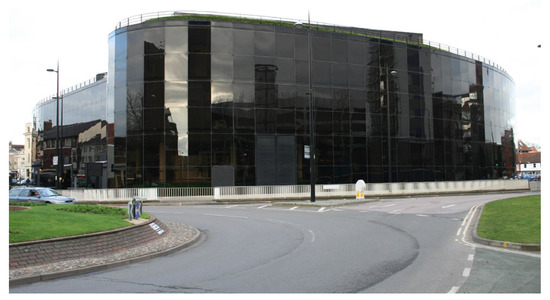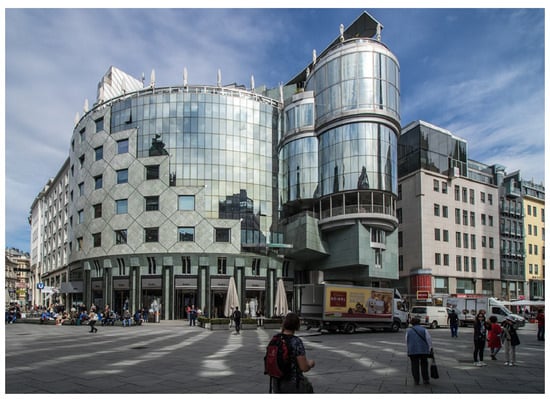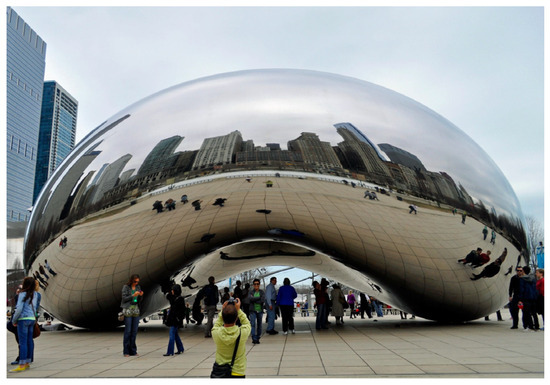1. Introduction
Materials have always been a critical and crucial element in directing architectural ideas and practice. The continuous innovation in the field of materials has changed how architecture is perceived and how concepts are generated and accepted. New materials have been influential in creating many innovative styles and shifts in architectural thinking, starting with concrete, steel, and glass, and continuing to nanomaterials, fiberglass, and self-healing concrete, which is used in shaping the parametric designs annotating contemporary architecture
[1]. Materials are becoming stronger, smarter, self-sustaining, more elegant, and eco-friendly. They are also becoming more dynamic and possess changeable properties to meet users’ needs.
Glass, with all its qualities, captured both theoretical and practical interest, dominating twentieth-century architecture with its physical and conceptual interpretations. The new material arose at the end of the 19th century and amazed both architects and users with the richness of its design possibilities, innovative potential, and aesthetic outcomes
[2]. Glass has two main physical properties, transparency and reflectivity. When used in the outer skin of a building, both traits have effects on architectural implications and messages to viewers, adding to the conceptual values of the building’s façade. The façade is an important part of a building, as it is the means of communication between the building itself and the public, and is the first encounter between the user and the building. Alzahrani asserted that the most significant and immediate approach to forming an opinion about a building is through its exterior look
[3]. Lee and Ostwald added that façades have attractiveness that is both visual and psychological
[4]. Jürgenhak clarified that the exterior and interior, as well as the public and private, are split by façades, ‘a functional skin, the representational element, and a boundary protecting the inner and negotiating with the outer world’
[5]. The materials used in façades are major components in their design and have a strong impact on and key role in delivering the messages intended by the architects for the viewers.
Although reflection and transparency exist together when glass façades are utilized, transparency was more popular in conceptualization and explanations by both architects and critics, especially during the modern architecture era
[6]. Currently, reflective façades are intentionally being revisited by architects. These architects are reintroducing reflective materials in the concepts of their buildings and designs, taking advantage of the availability of cutting-edge materials that facilitate their use on large surfaces; they are satisfied with the contemporary and futuristic look these materials give the beholders.
2. Transparency: The Beginning of the Journey
Modern architecture had an intense effect on architectural theory and practice as it established different theories and provisions, some of which were paradoxical or controversial; it impacted architecture from the late 19th century to this new millennium. One of those contradictory ideologies was the prohibition of ornaments while promoting and hailing transparency by allowing it to become a new type of architectural expression, creating a new form of aesthetic sensibility, and opening unlimited possibilities for visual perception. As stated in the Encyclopedia of 20th Century Architecture, the transparency of the new architecture suggested a revolutionary, classless society based on freedom and flexibility
[7], as it became the honest, natural ornamentation that compensated for the artistic, forbidden ornaments. According to Rowe and Slutzky, transparency was the subject of much critical analysis, which described its literal and phenomenal or perceptual and conceptual meanings. They stated that transparency provided multiple complex implications and concepts other than its physical properties of displaying clearly what was behind it, permitting the inside to be observed from the outside, and vice versa, or being able to see what was in a space while physically being in another space adjacent to it
[8].
Glass, the symbol of industrialization in modern architecture, was essential to the materialization of these ideologies as it acted as a neutral presence, or as Alexander D’Hooghe phrased it, its ‘presence would be studied as a kind of absence; whose form would have no expression’
[9]. Although there are two physical properties of glass, namely, transparency and reflection, transparency was the characteristic studied and targeted more by architects and critics. Transparency in glass allowed for the overlapping and penetration of spaces. It enabled spaces, which previously could not be seen together, to be viewed at the same time. It permitted ‘simultaneity’, which means seeing various aspects of an object at the same time without moving, and it reflected time as the fourth dimension in architecture
[10]. Gudkova and Gudkov added that it contributed to the idea of ‘freedom’ that prevailed in modern architecture by freeing the boundaries between the inside and the outside, adding extra space to interiors, and communicating with the exterior
[11]. Mies Van Der Rohe declared the rise of abstraction in his façades by using flat sheets of glass in his pavilion, houses, and skyscrapers, producing skin-and-bones architecture with crystal façades connecting the indoors with the surroundings. He favored transparency over reflection in his glass façades, expressing his reservations concerning the huge amount of light that is reflected by glass mirrors and its effect on the urban context
[12]. Apostolou stated that transparency ‘…creates multiple readings of spatial relationships and their connections. It allows flexibility in the organization of the composition.’
[13]. Mies Van Der Rohe and other Modernist architects are to be thanked for advancing the material of glass by emphasizing its transparency qualities. Balik asserted that transparency was ‘read as an ephemeral and temporal artwork’ as its quality and degree changes throughout the day and according to environmental conditions and passersby positions
[14]. Glass continued to liberate the user from his enclosure by promoting transparency to connect with the outside context.
In Postmodern architecture, this emphasis on the relationship between the inside and outside of a building was not prominent, as the style and form of mass gained greater importance in design concepts. Later, Norman Foster and others adopted the high-tech style, using vast amounts of glass to cover entire walls in their buildings and revealing daily life in them. Connections between the passersby and the occupants of the buildings were established, creating a new state of continuity, clearance, and an invitation to remotely share the experience. Conceptually, the glass curtain wall had two integrated functions of the same importance. The passersby sharing the experience of what is inside the building was as important as the inside user connecting to the surrounding context. The Willis Faber and Dumas Headquarters designed by Norman Foster (1975) came with a twisted feature taken from transparency. Dark smoked-glass curtain walls were used with curved corners and recessed building structures, creating continuity of the glass façades and a new experience of reflection
[15]. The building acted as a temporal mirror of the surrounding context in the morning and revealed the inner activities at night through the transparency of its glass façades (
Figure 1). Whether the reflection was intended by the architect or not, it established a new and different design statement in architecture.
Reflection seemed like a new output of glass that withdrew some of the main characteristics of transparency. Not only did it stop the connection between the outside and the inside from the outsiders’ position, but it also completed the scenery of the existing context and concealed what was supposed to be unveiled. At that moment, the building’s glass façade gave a message negating what was expected from it through a slight alteration in the material used.
Hans Hollein, another key figure in Postmodern architecture, tried to free himself and his Haas House from imposing historical references on the building, a typical characteristic of Postmodern architecture
[16]. Instead, he used a mirrored glass façade to reflect the context of historical churches and traditional buildings (
Figure 2), thus enhancing the connection between the building and its surroundings. He purposely used the reflection characteristic of glass as an architectural concept in designing his building.
In deconstructive architecture, metallic claddings were a prominent feature that enhanced the iconic characteristics of buildings. Despite this, reflectivity was not considered a main design concept feature. In the Guggenheim Museum in Bilbao (1997) and The Walt Disney Concert Hall in California (2003), designed by the star architect Frank Gehry, metal cladding panels, and the curves of the façade, brought dynamic colors to the buildings by reflecting their ambient conditions, and thus changing how they looked from day to night
[17]. However, the panels were not completely reflective and were not intended for reflection, either in their materials or concepts.
3. Implication of Glass from Transparency to Reflection
Many architectural texts have discussed the relationship between the intentions of architects in using transparency in their designs and the outcomes that are perceived by the people. Transparency is linked to openness, purity, spatial continuity, seeing what is behind, and layering of both hidden and visible elements, whether literally or symbolically. Many classifications were set to types of transparency or their outcome products. The most seminal was by Rowe and Slutzky (1956), who defined transparency as phenomenal and literal, as the physical quality of a substance. Shimmel stated that their papers were ‘…influential in shifting the interpretation of transparency’
[18]. Another classification was performed by Adrian Lo, who divided transparency into perceptual and conceptual
[19]. Herzog in his ‘Treacherous Transparencies’ analyzed transparency as conveyed in architecture and art, trying to understand the intentions and goals that motivated its use by architects and artists
[20]. Brzezicki explored conceptual transparency in depth and declared that some transparent architectures were not intended to be transparent. He saw that supplementary effects made to glass such as printing, fritting, and tinting through glazing technology took transparency down a more obscure path
[21].
In contemporary architecture, the development of glass materials, technology, and installation techniques has pushed the boundaries of transparency. New versions of glass address its two major defects, loss of privacy and massive heat stress. Voronkova emphasized the significance of making the right decision about the glass used for glass façades; she stated that the decision should be made at the building design stage
[22] to optimize thermal efficiency, control ventilation, offer noise insulation, and enhance visual comfort. Glass type, size, scale, color, and design have become crucial elements in the aesthetic success of buildings. Smart glass has dominated architectural glass designs, allowing the user full control to choose the degree of opaqueness he desires according to his mood or needs. Brzezicki discussed new ideas such as inviting the observer to the ‘game of guessing’ by using translucent glass
[21]. This is achieved by preventing the whole picture from reaching the viewer, allowing his own interpretation and speculations, and replacing the clarity and openness of transparent glass.
In parallel, using intentional pure reflection in the architectural façades of buildings began to appear as a new conceptual phenomenon in architectural design. Although reflection is one of the outputs of glass, similar to transparency, it has different implications, especially when it is intended by the architect. Previously, both effects of glass coexisted side by side: transparency was intentional, and reflection was the collateral effect. Now, transparency fades, and pure reflection stands out. Transparency and reflection could be viewed as two contradictory, but complementary, traits. Transparent glass can mirror the surroundings while allowing a viewer to see through it, but glass mirrors only reflect their surroundings and do not reveal what is behind them. In glass, opacity decreases to zero for transparency and increases to reach its maximum for reflection. Distorted superimposed views of an interior can be seen depending on the position of the viewer and according to the physical characteristics of the glass façade. The same occurs with mirrored façades, but the views are of the surroundings, and the virtual images are created depending on the degree of reflectivity of the glass. Transparency shows with honesty, but reflection hides with illusion. Transparency implies lightness, revelation, and mobility, but reflection suggests heaviness, obscurity, and steadiness. Both have dynamic effects, as they show or reflect the motion behind or in front of the glass, giving a sense of continuity and blurring the borders between the interior and the exterior. Transparent glass façades target the interior users, connecting the interior space and the surroundings, or sharing the experience inside with the passersby. On the other hand, mirrored façades aim to blend the building’s mass with its surroundings for the passerby’s interactive experience.
In the Merriam-Webster dictionary, ‘reflection’ is defined as the return of light or sound waves from a surface or giving back the image by a reflecting surface. Architects developed their practice when designing contemporary buildings: first, using simple glass or smoked-glass walls with a natural reflective effect and, later, using claddings with the intention of developing reflectivity as part of the façade’s conceptual design. Reflected glass, back-painted glass, metal sheets or panels, polished stainless steel or polished aluminum or composite, high-gloss paint, and reflective ceramic panels are all options that give a reflective effect to the building through the façade cladding material
[23]. These materials could be polished, perforated, and/or textured to change their level of reflectivity and the degree of picture purity. All materials used for an intended reflection effect must have a glossy feature: as Fleming et al. affirm ‘…specular reflections lead to complex image’ and variation occurs due to the change in form of the surface or the amount of light falling on it
[24]. Anderson added that the images reflected by surfaces could be visually perceived as superimposed on each other, blurred, or even distorted, depending on the geometry of the reflecting surface
[25] or/and the position of the viewer.
Aesthetically, mirrors in façades change boundaries, stand out, and make a statement. They attract passersby and turn buildings into icons in the urban context, contributing to place-making. A sculpture with a reflective surface standing in Millennium Park in Chicago has marked the neighborhood. Its form and effect were inspired by a liquid mercury drop, and its shiny exterior reflects the people, the activity, the skyline, and the greenery surrounding it. This sculpture invites people to interact with its mirror skin, seeing themselves from different angles and capturing a moment with their images reflected along with the surrounding context, with some deformations in the proportions due to the oval–like shape of the form (Figure 3).
On the other hand, Sen and Khazanovich asserted that reflective façades can raise urban air temperatures by deflecting sunlight onto nearby objects and pedestrians; this also increases cooling energy demands
[26]. According to Ishak et al., reflective façades indirectly contribute to the problem of urban heat islands by reducing outdoor thermal comfort, producing undesired glare, and creating a rise in global warming
[27]. Mehaoued and Lartigue concurred with this, stating that employing reflecting façades in hot areas has a significant thermal influence on raising the temperature of the atmosphere and the energy required for cooling
[28]. Consequently, even though reflecting façades might lessen heat transmission within the building and aid in lowering inside temperatures, their negative environmental effects still exist. Fortunately, numerous technical approaches
[29][30] have recently been developed to address these problems including adding reflective coating films and new sources of reflective materials.
This entry is adapted from the peer-reviewed paper 10.3390/buildings13112740



